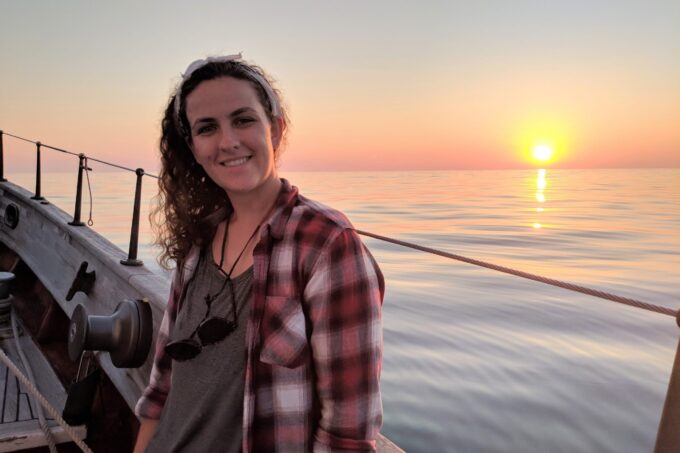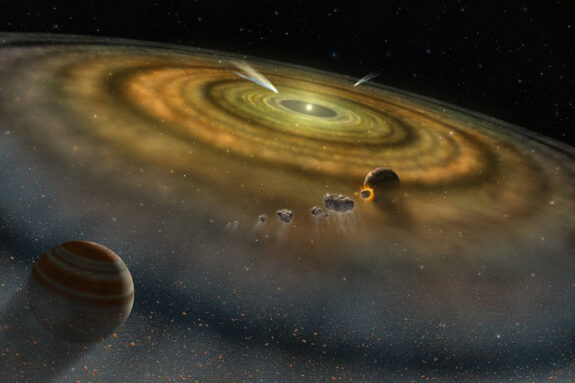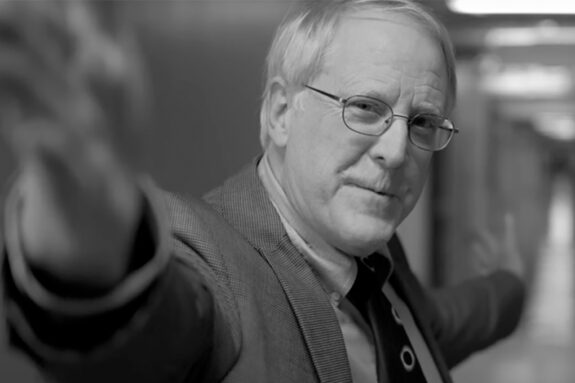Spotlight: Kayla Gardner explores the Ocean Twilight Zone

Read this at Ocean Twilight Zone | Woods Hole Oceanographic Institution
MIT-WHOI Joint Program graduate student Kayla Gardner has always been fascinated by small things. As a high school student, she fell in love with marine biology—not by watching dolphins or whales, but tiny zooplankton under a microscope. “Those are my kind of animals,” she says. “When you see a high density of diverse organisms, watch them move, see how colorful and vibrant they can be—that’s what hooked me.” Today, she’s a PhD student in WHOI biologist Simon Thorrold’s lab, where she aims to better understand the food webs of the twilight zone. In this interview, learn more about her background, her research, and her role on the Ocean Twilight Zone (OTZ) team.
What kinds of questions are you trying to answer about the ocean twilight zone?
I look at samples of muscle tissue from fish in the twilight zone, and use a biochemical method to figure out where they’re getting their food. Mainly, that involves extracting essential amino acids, and finding the ratio of stable isotopes of carbon and nitrogen inside of them. The stomach contents of a fish will give you a snapshot of what it ate on a particular day, but by looking at stable isotopes in its muscles, we can get a sense of what it eats over weeks or months. We can use that analysis to tell if its food source is based in surface or deep water ecosystems, and learn what types of species make up the bulk of its diet. It’s really powerful. It’s also a totally new approach from what I’m used to doing, which is looking at marine life under a microscope and counting cells.
When did you first realize that you wanted a career in ocean science?
I grew up sailing and scuba diving, so I’ve always had a heart for the ocean. It’s my happy place. Marine science just seemed like a natural fit career-wise—but I wasn’t actually exposed to it until high school, when I did a three-week academic camp through Duke University. While I was there, I took a class with an oceanographer who said on day one, “I hate dolphins. I love seagrass. By the end of this, you will, too.” She showed us what real marine scientists do every day. And she was totally right—by the end of the course, I fell in love with the work.
In addition to research, you’re really passionate about educational outreach. What attracts you to that?
Well, so much can happen to our ocean without people realizing it, because the damage is out of our view—but we are deeply affecting it with our daily lives. I want to change that. I’ve always been really adamant that the science I do should be able to inform policy, and that I make a point of engaging with communities about getting more involved in conservation. Some friends and I recently started an after-school club called “ocean exploration” at a local elementary school here in Falmouth, for example. We do a bunch of lessons about the ocean with the kids, ranging from dissecting a squid to basic physics, like how a hurricane affects a shoreline. I really love engaging in those kinds of efforts, because even if these kids don’t go into marine science, they still may be able to affect and contribute to marine conservation in huge ways. If they work for a big corporation that has money and means, they could help to make that company’s processes sustainable, or help limit plastic in products, or something like that. That could potentially have a bigger impact on the ocean than I can as a scientist. You don’t have to be a marine researcher to engage in conservation; you just need some inspiration, or passion, or interest.
You’re also really interested in graphic design—how does that fit into your work?
My parents are both artists. My dad’s an architect, and my mom’s a graphic designer, so I’ve been steeped in that way of thinking from an early age.I really think graphics and visuals are a phenomenal way to educate people, and get them involved in caring about the ocean. The lay person is a lot more willing to engage with a poster that’s visually appealing than one that they look at and just automatically assume they won’t understand. I think just making that effort visually with graphics and design can go a long way, especially In talking to audiences that might not normally engage with those kinds of things.
That led to a pretty memorable moment at sea. Can you describe what happened?
Oh, sure! I was aboard the R/V Bigelow in 2019, when we were testing Deep-See, and some of the scientists who designed it found out I’m interested in graphic design. Next thing I knew, they were asking me to add some artwork to the side. It was super intimidating and exciting—like, “hey, want to spray paint my multi-miillion dollar vehicle?” I’ve never even worked with spray paint. I just raided the ships’ supply, which obviously didn’t give me a huge range of colors. It was really interesting having those limitations. Based on the materials we had, I couldn’t do much stenciling and couldn’t use a wide palette, so I had to go with something simple but graphically appealing. Andone Laverty, the PI in charge of Deep-See, wanted it to look different from other oceanographic vehicles, which have a very clean, sleek look. She definitely got her wish—I ended up making spray-painted octopus tentacles that fanned out like flames on a car. I also tagged super loose interpretations of our funding sources’ logos on the tail fins. It was all very intentionally rough, but also iconic visually. It was a really great way to overlap art and science.
Story Image: Kayla Gardner, a PhD student in the MIT-WHOI Joint Program, aboard the SSV Corwith Cramer. (Photo: Erik Olsen)


